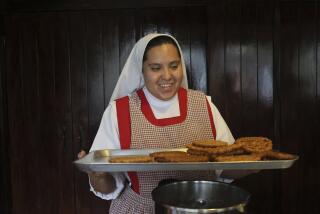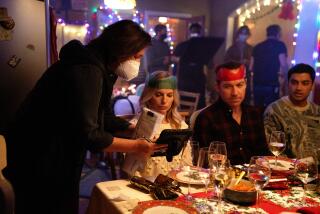TV REVIEWS : Nuns Down Under in ‘Brides of Christ’
- Share via
Seldom has Catholicism been dramatized with such uncompromising, lively and illuminating focus as in the absorbing six-hour miniseries from Down Under “Brides of Christ.”
The Australian production, nominated for an international Emmy, airs in three parts over A&E;: Sunday at 5 and 9 p.m., then Monday and Tuesday at 6 and 10 p.m.
“The life of nuns has always been a mystery to those in the secular world,” says hostess Jean Marsh in introducing the series. And gradually, as in a hefty novel, a mystery does unfold as we come to experience the texture, the caring, the crises and turmoil of what is a totally alien realm to most of us: life inside a novitiate.
Here is a cloistered world brimming with life. Australian nuns, novices, their female students and several outside characters come and go in stories that peel away characterization and social and religious themes layer by layer.
The series starts rather leisurely but gathers surprising momentum in a set of luminous performances from mostly fresh faces, an exception being Oscar winner Brenda Fricker (“My Left Foot”) as a scowling, surly sister who eats novitiates for breakfast.
But she’s not Nurse Ratched in a habit. Nor is this “Sisters” or all those movies about Catholics that cloak the Church in either sentimentality or friendly satire. While many of the “brides” of Christ here are bedeviled by clashes between their sacred vows and inner desires--one rebellious student (the vivid Kym Wilson) and a yearning nun (the demure Lisa Hensley) flee the novitiate for lust--this production is far more ambitious and richly visualized than a tabloid glimpse inside a convent.
Crucially, writers John Alsop and Sue Smith, under the measured direction of Ken Cameron, have set the action in the 1960s, a period of volcanic, stressful change in the Catholic Church as well as outside it. The plot dramatizes in this remote clime the time of Vatican II, with Rome loosening centuries-old traditions and rites.
The achievement of the miniseries is its winning ambiguity. It’s neither mean-spirited, cynical nor flabby. It’s able to criticize and rebuke the practices of the Church (notably its monied, male hierarchy and its stand on birth control) and at the same time genuinely convey the spiritual and communal warmth and love of these women and, by extension, the religious fervor that brought them together.
More to Read
The complete guide to home viewing
Get Screen Gab for everything about the TV shows and streaming movies everyone’s talking about.
You may occasionally receive promotional content from the Los Angeles Times.






